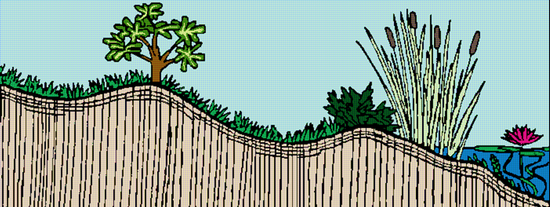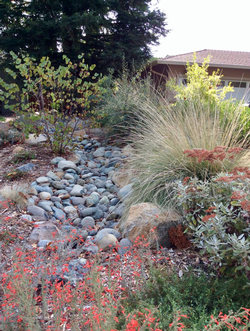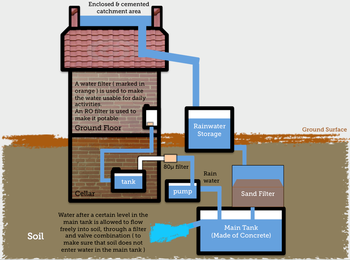How to harvest rainwater
-
From late fall through spring, nature can bring storms to Marin with forceful wind, pelting rain, thunder and lightning, even a bit of hail. Water is everywhere -- streaming off rooftops, sheeting down driveways, turning curbside gutters into turbulent little rivers and storm drains into veritable whirlpools.
However, California may face additional drought periods in the future, and it seems like such a waste -- all that fresh water literally going down the drain. And as it travels, the water picks up myriad pollutants that wend their way to San Francisco Bay or the ocean, dumping a variety of unwanted materials into those delicate ecosystems.
Pouring down rain may not seem like the time to think about conserving water and protecting the environment, but it is actually a good time to assess how to better utilize the precious liquid. Rather than letting it funnel down rainspouts and head right for storm drains, why not find ways to capture it, slow it down, spread it out, and let it soak in?
 Rain gardens allow water to flow downward and settle into lower areas. Photo: UC Regents
Rain gardens allow water to flow downward and settle into lower areas. Photo: UC RegentsMarin County’s fresh water supply
Marin's fresh water supply comes from rainfall collected in reservoirs during our rainy season. The rainwater is treated to potable standards, as defined by the U.S. Environmental Protection Agency (EPA) Safe Drinking Water Act, by one of the municipal suppliers and delivered to customers for use indoors and outdoors. Once used, it either goes to the sewer system (general indoor uses), is absorbed into the ground (irrigation and other outdoor uses), or travels to a storm drain that ultimately flushes out to the bay or ocean (runoff).
Rain runoff, water down the drain
In an undisturbed natural environment, rainwater is either infiltrated into the ground, evaporates, is taken up by plants, or runs off the surface:
- 50 percent of rainwater infiltrates into the ground
- 40 percent evaporates or is taken up by plants
- 10 percent runs off the surface
The percent of rain runoff can increase to 20 or 30 percent in developed areas with their increased hard, impervious surfaces (roof tops, driveways, patios, sidewalks, streets, and parking lots). That is a lot of water heading right down the proverbial drain. As Marin is dependent on the cycles of nature to provide us with an adequate supply of fresh water, it makes sense to maximize our ability to capture and use this valuable resource.
How to harvest rainwater
Rainwater harvesting -- or rain gardens as they're commonly known in much of the country -- are designed to collect, hold, move, and infiltrate rainwater runoff from hard, impenetrable surfaces to another location within an individual site. They can augment irrigation supplies, help improve drainage problems, increase the amount of water that filters into the ground to recharge groundwater supplies, protect creeks and streams from pollutants, and provide valuable habitat for birds, butterflies, and beneficial insects, all while enhancing the beauty of yards and neighborhoods.
The age-old practice of collecting and storing rainwater in a holding vessel for later use has become increasingly popular. There are many options available, from simple barrels connected to a downspout to large-capacity tanks. It is easy to capture a lot of water: an inch of rainfall collected off a 1,000-square-foot surface captures up to 600 gallons of water.
Slowing the movement of water during periods of intense flow can be accomplished with a variety of different design elements that retain water on the landscape itself so that it can soak back into the ground. Designs can look like traditional landscaping, employing a variety of trees, shrubs, flowers, and other plants that tolerate wet and dry conditions. Beneath the plants, layers of mulch, soil and sometimes gravel catch excess water and slowly disperse it through the ground and back into the water table.
All impervious surfaces such as roofs, driveways, or patios, will generate large quantities of water during rainfall. Harvesting this water puts it to use. Fortunately, there are many simple and inexpensive ways to do this.
Moving soil around Rain gardens are beautiful, functional, and help to slow, spread, and sink water. Photo: UC Regents
Rain gardens are beautiful, functional, and help to slow, spread, and sink water. Photo: UC RegentsThis is one of the easiest and least costly ways to retain water in your landscape. The key is to observe where water goes during a rainfall and determine how best to slow it down so it can soak into the soil. Sometimes this is as easy as slowing the flow of water at the bottom of a gentle slope. A series of swales and berms, and terracing are two ways to harvest water on slopes.
Swales and berms
A swale is a shallow ditch excavated along the contour of a slope. The excavated soil is placed on the downslope side of the swale to create a mound of earth, or berm. Swales and berms can take many forms and can be designed to retain a little or a lot of water. Plants placed in the swale or along the lower part of the berm will benefit from added moisture. Swales and berms can be built so that excess water flows into another swale farther down the slope. A wide, shallow swale combined with a low berm is barely noticeable when it’s covered with vegetation.
Terraces
A terrace requires the use of stone, wood, or other material to create a retaining wall where the slope is cut to make a flat planting area. Small terraces are potential do-it-yourself projects, but large terraces often need to be professionally constructed to make sure the retaining wall won’t collapse from the weight of the soil behind it.
French drains
French drains are covered trenches used to spread out excess water. They can be used to direct rainwater from hard surfaces to areas of the landscape that need extra water. There are several ways to make a French drain. One possibility is to dig a trench from the water source (roof, driveway, and parking lot) to the area where water is needed. Make sure the trench has a slight slope away from the water source. Place a perforated PVC pipe in the bottom of the trench, line the trench with gravel, and backfill with soil.
Rain barrels
Place rain barrels under downspouts to catch rainfall as it runs off the roof. The barrels often have spouts at the bottom to access the water for irrigation. Rain barrels can be connected with piping to create larger storage capacity, or there are portable cisterns that can be used in conjunction with rain barrels. To capture the maximum amount of water, there should be a rain barrel under each downspout.
Cisterns Rain gardens range from simple swales and berms to elaborate systems with tanks and pumps. Photo: Wikimedia
Rain gardens range from simple swales and berms to elaborate systems with tanks and pumps. Photo: WikimediaCisterns are large-capacity containers, either above or below ground, typically used to store rainwater. Rainwater is directed off the roof through gutters and downspouts into the cistern. The roof of a typical house will generate thousands of gallons of water that can be used for irrigation during the dry season. A submersible pump can be used to gain access to the water in underground cisterns, while many above-ground cisterns operate on gravity flow. Cisterns can hold large amounts of water but can be fairly expensive to install, particularly those that are underground.
Graywater
Graywater collection is the system whereby household water from bathroom sinks, showers, tubs, or laundry is collected for landscape irrigation. Any residence has a large potential supply of graywater, but there are regulatory requirements governing its use due to the potential for pathogens in the water. If used, graywater is suitable only for ornamental landscapes, not for food crops.
For more information:
- Coastal California Rain Gardens
- United States Environmental Protection Agency (EPA)
- Rainwater harvesting in San Francisco
- Marin Municipal Water District (MMWD)
- Salmon Protection and Watershed Network (SPAWN)
Original content by the UC Sonoma Master Gardeners and by Nanette Londeree for the Marin IJ
Edited for the Leaflet by Lisa MacCubbin



